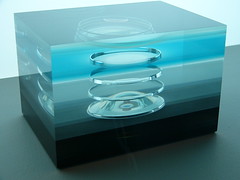The group of pilots at my home airport, the Cherry Ridge Pilot's Association, planned a fly-out for yesterday. Fly-outs are trips where several members in the group will all fly to the same place together, timing their arrival to coincide, despite the different performance of their planes. It serves as a social function, and a way to enjoy the hobby (obsession) of flying light aircraft.
Yesterday was to have been to Alton Bay, New Hampshire to land on an ice runway on a frozen lake. But when word came that the runway was unsuitable for landing, it was changed to Corning, New York; another area club was flying there, too. There is a warplane museum on the airport at Elmira-Corning, and the group planned on lunch and a tour of the restoration hangar.
I pitched the idea to Gail, but with a different attraction in mind; the Corning Museum of Glass. I'd been there many years ago, and since then it has been totally remodeled and doubled in size. It's sort of a hidden treasure in upstate New York, filled with beautiful art, antiquities and science. Lured by my promise of wondrous things to photograph, she liked the idea.
We arrived at the hangar a bit late to catch the others for lunch; most of them fly later-model planes that can outpace the Tri-Pacer by a few knots, so we would have had to leave sooner to meet them at noon. But we were going our own way anyway. The weather was mostly clear, but cold, with temps aloft of -18C. We took off into partly-cloudy skies and turned into the stiff headwinds from the northwest.
Even with the heater going full blast, it was slightly cold in the cabin. The walls and doors of this old plane are just two layers of thin synthetic fabric; and far from being pressurized, it leaks air around the windows and doors. As I checked that the outside air temp was in fact below zero (-20C), I recalled the flight home from Nashville, Tennessee when it was almost 100F. Temps in the cabin on that day were over 120 degrees (48C)! I have truly been to the extremes of temperature now... I hope. The GPS estimated 1:03 as our travel time to Elmira/Corning, and Gail got cozy next to me and fell asleep for a bit, once the turbulence died down.
By the time we got to Elmira, the cloud cover was solid just above us at 4500 feet. It must be a quiet town, as the controller cleared us to land when we were eight miles out. At the small-aircraft base we found that two of the three courtesy cars were out (probably with my mates from home!) and the third had a sick transmission. So we had to bite the bullet and rent a Hertz to get to the museum, but at least we had a good car for the day.
The museum was great - full of amazing things, bigger, and beautifully redesigned. Gail took a volume of photos, her account of the day is here. (Her photos were up Saturday night, she stayed up late posting them.) We stayed all afternoon and only left when the museum closed; we will definitely be back to see the things we missed. We had a great full supper at an Italian place in old Corning.
On the way back to the airport, I was shifting back into pilot-mode, mentally checking off my concerns about the cold, the dark and the weather. I called the Flight Service Station and got a loquacious controller, who advised me to file a flight plan, and warned me of approaching snow on the radar. It seemed to be getting bad to the northwest, moving in quickly with the prevailing wind; but our destination was still clear below 6,000 feet with 10-mile visibility. I decided that the best course was to leave immediately - conditions were still good to depart Elmira, and the bad weather moving in would likely last two days.
We bundled up and took off, and I was able to get to 3,500 feet with no trouble. We were flying in light snow, which concerned me a bit; I occasionally flicked on the landing light to look for any buildup of snow or ice on the plane. But visibility improved, with occasional patches of bright moonlight; and we were being pushed by a powerful tailwind. The GPS unit showed us covering ground at almost 140 m.p.h., thirty more than 02P can fly in still air. Gail slept and I flew as the villages of rural New York and then Pennsylvania passed below us.
In only forty minutes we were descending into Cherry Ridge, happy to see that the runway lights are all working now. (Thanks, Rick!) It was warmer than in New York, but only in a relative sense! We have our routine down; to minimize our exposure to the cold, Gail jumped out and pulled the car out of the tin hangar while I postflighted the plane and pushed it inside.
